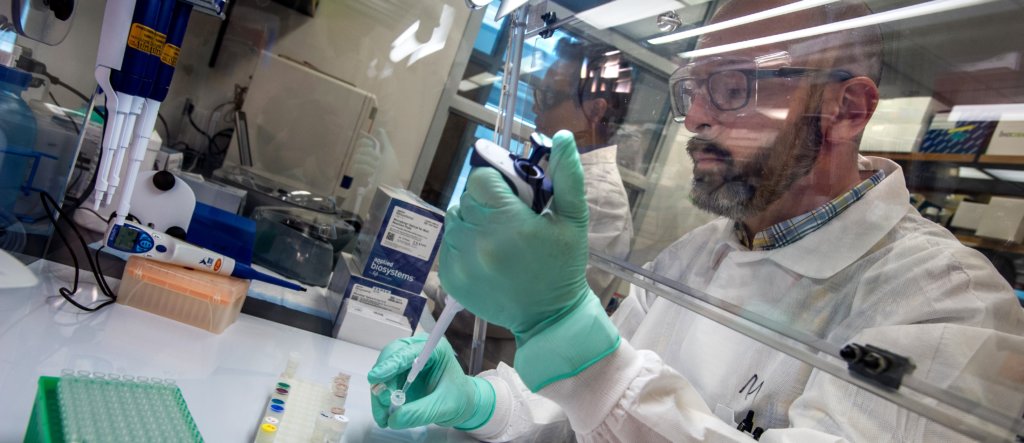
David Line is an assistant professor and director of Eastern Washington University’s Master of Public Health Program. In his more than two decades of experience prior to joining the EWU faculty, Line has, among other notable roles, served an incident commander during outbreaks of the pneumatic plague, hantavirus, West Nile and measles in Arizona and New Mexico. During this time, he also served with the New Mexico State Police search and rescue team, acting in a variety of capacities that included planning, logistics, operations and public outreach.
His research interests at Eastern include qualitative and quantitative studies on services provided to medically involved youth, water quantity and its impact on public health, and online education.
In advance of a segment for Eastern’s Spokane Talks video podcast, available below, Line shared with InsideEWU several insights into the scientific community’s understanding of SARS-CoV-2, the virus responsible for the COVID-19 pandemic. He also unpacked some the terminology and processes that epidemiologists use to track and contain the illness and shared his thoughts on the trajectory of the current crisis. His responses were lightly edited for length and clarity. Please see our live interview for more detail.
Dr. Line, thank you for joining us. We’ve all heard a lot about “flattening the curve” of infections associated with the SARS-CoV-2 virus. Can you help our viewers understand the concept of the “epi curve,” how these curves are plotted and why they’re so important?
The curve is a graph which has time along the bottom (or X axis) and the rate on the vertical axis (or Y axis). Thus, we plot how many infections, hospitalizations or deaths occur each day. Typical starting dates are the day that the 10th or 25th person died.
When looking at graphs it can be helpful to look at exponential rates on the y-axis. When looking at dramatic increases, as we are now, it can be hard to see changes in rates. When looking at exponential rates, we can see the changes in rates easier.
“Flattening the curve” is possibly the most important strategy we are currently pursuing. If we do not flatten the curve, we will increase the death rate from the disease—this because more people who might survive will not have the services they need to survive. If we do not flatten the curve in the United States, the death rate from COVID-19 is likely to exceed the top ten causes of death combined at over 2 million people.
Another reason to flatten the curve is to spread out the rate of infection so that the demand for services—such as respirators—can stay below the supply of these services. The problem is that reducing the outbreak rates requires us to either change the biological parameters or the social parameters. Since we cannot change the biological parameters at this time, we are focusing on the social parameters. This means social distancing as accomplished by closing and cancelling things. And this means we are going to create an economic impact which will also have health impacts. Thus, flattening the curve also extends to economic challenges which should not be minimalized.
We’re also hearing the phrase “contact tracing” in association with efforts to limit the scope of the pandemic. How does contact tracing work, and why is it especially crucial in the early stages of an outbreak?
Contact tracing allows us to identify where transmissions are occurring. In early stages of an outbreak, this is a great way to isolate a disease and reduce its ability to spread by eliminating the number of people who come in contact with an infectious person.
Because of the apparently high rate of infection of SARS-CoV-2, and the fact that ongoing community transmission seems upon us, is it possible we are already past the point of effectiveness for tracing COVID-19 contacts?
Contact tracing for the purposes of transmission is still important for individuals. If we can alert an individual that they are contagious, we can eliminate the spread of disease by that person. This could be important if they are visiting high risk populations who are largely isolated.
Contact tracing also helps us to determine the reproduction number among other calculations, such as what environmental conditions support and decrease transmissions.
Speaking of transmission, can you help us understand the R0 (R naught)? How it’s calculated and what it’s telling us about transmission of the virus that causes COVID-19?
R0 or the Reproduction number is based on several parameters. Most common of these are: the duration of contagiousness; the likelihood of infection per contact between persons; the contact rate; and various economic, social and environmental factors.
COVID-19’s duration of contagiousness is longer than normal and overlaps the asystematic period. Thus, you can be contagious without showing symptoms.
Further, COVID-19 is spread through the air and by direct contact. In an aerosol state, COVID-19 can be contracted for up to 30 minutes. However, realistic times seem to be around 10 minutes. On surfaces COVID-19 can remain viable from 2 hours in the case of some fabrics, to one day for cardboard and three days for metals and hard plastics. All of these numbers are at near ideal temperatures (60 degrees) and humidity (60%) for the virus. COVID-19 does better in cooler temperatures and in lower humidities. It also does not fare well in direct sun light.
Because COVID-19 has a reproduction number of between 2 to 6, we can expect it to spread readily. Thus, if we want to reduce its ability to spread, we need to enact social measures to reduce the contact rate.

Are you at all optimistic that warmer weather might bring that R0 down and slow transmission?
Yes, for two reasons. First, COVID-19, as with other coronavirus, seems to be impacted by air temperature and humidity. Second, we tend to be outside more and not as confined. In general, COVID-19 spreads more in regions with cooler temperatures, from about 30 to 60 degrees (Fahrenheit). Other SARS virus have followed this trend in laboratory results. Other SARS viruses also did better in lower humidities.
The concern with this optimism is that COVID-19 will persist until cooler temperature occur. When cooler temperatures return, there is a potential for COVID-19 to return as the Influenza Pandemic of 1918 did in the Fall of 1918.
All signs point to direct zoonosis as the route of infection for China’s index case (patient zero) in the COVID-19 pandemic. How common are these types of animal-to-human transmissions, and what can we do to limit them in the future?
Zoonosis occurs frequently. In Texas there have been about 1,000 per year since 2000 over the 35 diseases they track. Of these almost half were West Nile. Washington state had about 600 in the same time frame. Most of
these are Dengue and West Nile. Common diseases which make the news are anthrax, bruecllosis, Dengue fever, Ebola, hantavirus, Lyme disease, malaria, plague, rabies, West Nile, and Zika virus.
Transmission from animals to humans occurs when we spend time around animals. These can be wild animals or pets (in rabies and plague cases). Most zoonosis diseases are spread by mosquitoes. In these cases, we can limit the transmission by using insect repellant with DEET, covering up, and avoiding locations and times when mosquitoes are out.
Not all animal to human disease transmissions are bad. Because of cowpox, milk maids developed an immunity to smallpox. This led to Edward Jenner’s development of a smallpox vaccination using cowpox. Being around animals can boost our immune system to fight off diseases.
When thinking about zoonosis, I break the diseases into two groups. Those which are not easily transmitted from human to human and those that are. Coronavirus is a major concern because it not only made the jump from animals to humans, but it is now being spread between humans.

